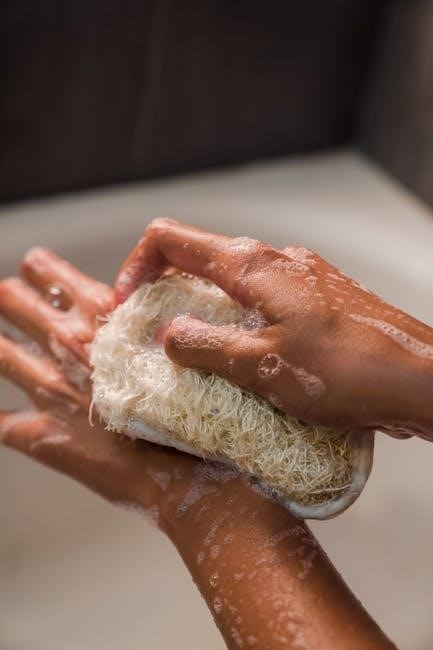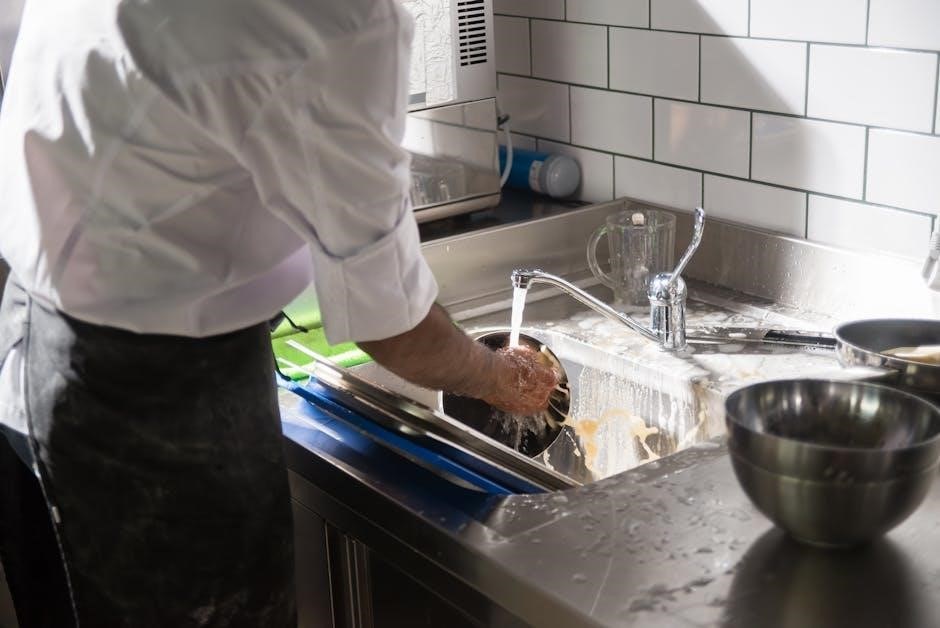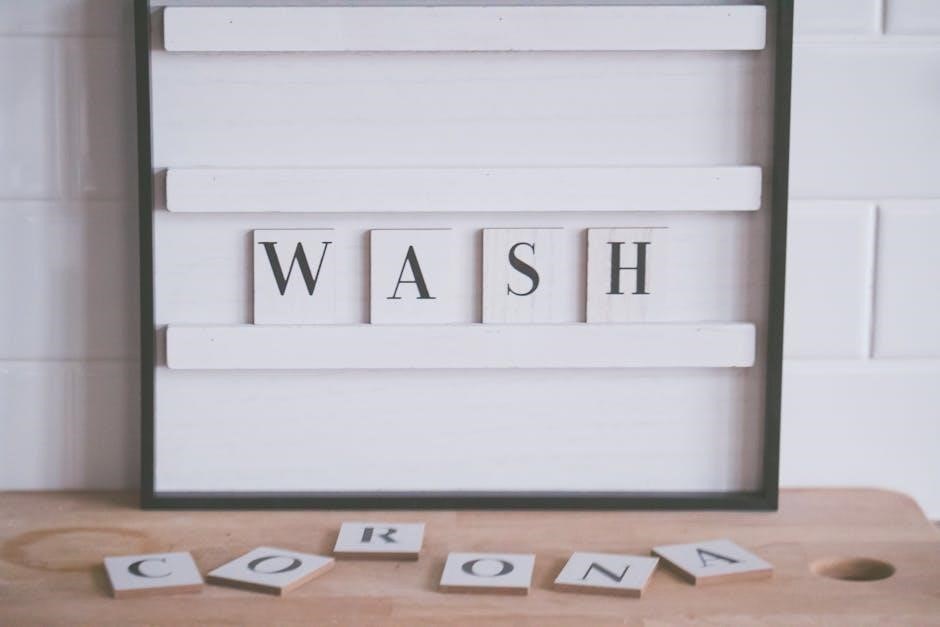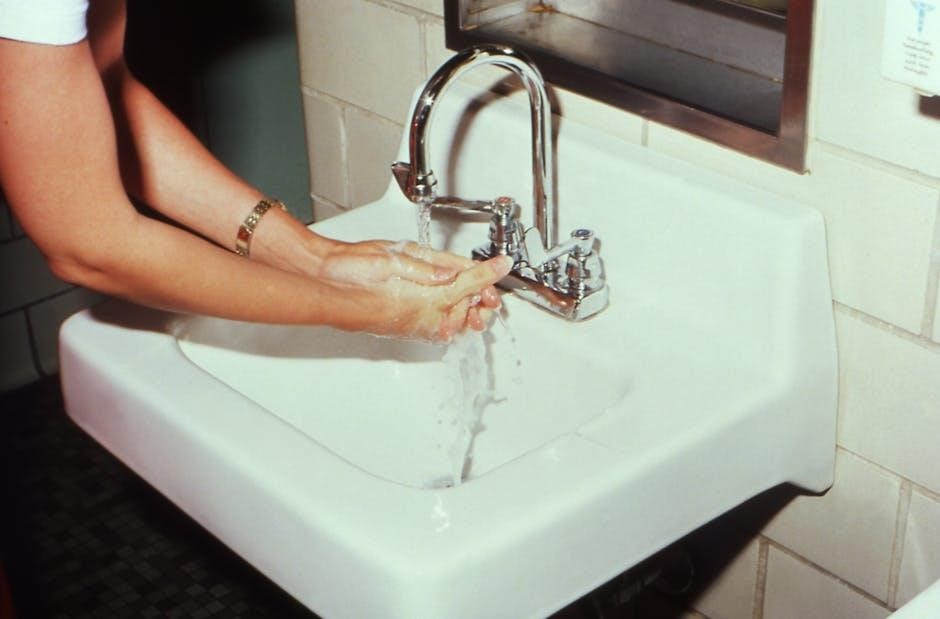
The OEKO-TEX Standard 100 is a global certification ensuring textiles are free from harmful substances, promoting product safety, sustainability, and consumer trust in fabric quality.
1.1 Definition and Purpose
OEKO-TEX Standard 100 is an independent testing and certification system ensuring textiles meet rigorous safety standards. It screens for over 1,000 harmful substances, guaranteeing products are safe for human use and environmentally friendly. The certification verifies that fabrics, from yarn to finished goods, comply with strict chemical limits, promoting consumer health and sustainability. Its purpose is to provide a reliable benchmark for textile safety, fostering trust and transparency in the industry. This label is globally recognized, helping consumers identify products that align with high safety and ethical production practices.
1.2 Importance of Certification
OEKO-TEX Standard 100 certification ensures textiles are free from harmful substances, providing a trusted guarantee of safety and sustainability. It builds consumer confidence by verifying compliance with strict chemical limits, promoting ethical production practices. This certification fosters transparency, enabling consumers to make informed choices about products that prioritize human health and environmental responsibility. It also supports manufacturers in demonstrating their commitment to quality and sustainability, enhancing their global credibility and market competitiveness. The certification is a cornerstone for responsible textile production, ensuring safer and more eco-friendly products.
1.3 Key Benefits for Consumers
OEKO-TEX Standard 100 offers consumers peace of mind by ensuring textiles are safe from harmful substances, making them suitable for all skin types, including sensitive skin. It guarantees high-quality, durable products that maintain their integrity through proper washing. Consumers can trust the certification as it verifies compliance with strict safety standards, reducing health risks. Additionally, it promotes eco-friendly practices, aligning with growing consumer demand for sustainable and responsible fashion. This certification empowers buyers to make informed decisions, supporting brands that prioritize safety, quality, and environmental stewardship. It is a reliable indicator of a product’s commitment to excellence and sustainability.

Understanding OEKO-TEX Washing Instructions
OEKO-TEX washing instructions emphasize pre-washing, gentle cycles, and mild detergents to maintain fabric quality and safety, ensuring textiles remain free from harmful residues while preserving their durability.

2.1 General Guidelines for Washing OEKO-TEX Certified Fabrics
OEKO-TEX certified fabrics require careful washing to maintain safety and quality. Always wash before first use to remove residues. Use a gentle cycle with cold water and a mild, eco-friendly detergent. Avoid bleach, fabric softeners, and harsh chemicals to prevent damage and ensure the fabric remains free from harmful substances. Reshape garments while damp to maintain their form. For delicate materials, hand washing is recommended. Following these guidelines helps preserve the fabric’s integrity and prolong its lifespan, ensuring continued safety and comfort for users.
2.2 Recommended Detergents for OEKO-TEX Certified Textiles
For OEKO-TEX certified textiles, choose mild, eco-friendly detergents free from harsh chemicals, bleach, and fabric softeners. Opt for detergents specifically designed for delicate or sustainable fabrics. These products are gentle on materials and the environment, ensuring the preservation of the fabric’s safety and quality. Avoiding aggressive cleaners helps maintain the integrity of the textile and prevents the introduction of harmful substances. Always select detergents with low environmental impact to align with the eco-conscious values of OEKO-TEX certification.
2.3 Role of Washing in Maintaining Fabric Safety
Washing plays a crucial role in maintaining the safety and integrity of OEKO-TEX certified fabrics. Proper washing removes residues, prevents chemical buildup, and ensures the fabric remains free from harmful substances. Using gentle cycles and recommended detergents preserves the material’s safety and quality. Regular washing also prevents the accumulation of allergens and odors, maintaining hygiene and comfort. By adhering to washing guidelines, consumers can enjoy durable, safe, and environmentally friendly textiles, aligning with the standards set by OEKO-TEX certification.

Testing Parameters for OEKO-TEX Standard 100
OEKO-TEX Standard 100 tests textiles for over 1,000 harmful substances, ensuring strict chemical limits and safe washing practices. It guarantees fabrics meet rigorous safety standards for consumer protection.
3.1 Harmful Substances Tested
OEKO-TEX Standard 100 tests textiles for over 1,000 harmful substances, including phthalates, heavy metals, formaldehyde, and allergenic dyes. These tests ensure fabrics are free from chemicals that could harm human health or the environment. The certification also checks for residues of pesticides, chlorinated organic compounds, and other volatile organic compounds (VOCs). By setting strict limits on these substances, OEKO-TEX guarantees that certified textiles are safe for use, especially for sensitive groups like children. This rigorous testing process ensures that fabrics meet high safety standards for consumer protection and environmental sustainability.
3.2 Threshold Limits for Chemicals
OEKO-TEX Standard 100 sets strict threshold limits for harmful chemicals in textiles, ensuring they meet safety standards for human health and environmental protection. These limits are based on European regulations, such as REACH, and apply to substances like phthalates, heavy metals, and formaldehyde. The certification ensures that chemical residues in fabrics are below safe levels, making them suitable for sensitive groups, including children. By adhering to these thresholds, OEKO-TEX promotes responsible material sourcing and reduces environmental impact, aligning with global sustainability goals.
3.3 How Testing Ensures Safe Washing Practices
OEKO-TEX Standard 100 testing ensures safe washing practices by verifying that textiles meet rigorous safety standards. The certification process involves testing for over 1,000 harmful substances, ensuring fabrics are free from toxic residues. This rigorous testing guarantees that certified textiles can withstand washing without releasing harmful chemicals, protecting both human health and the environment. By adhering to these standards, consumers can trust that their OEKO-TEX certified fabrics are safe for repeated washing, reducing the risk of allergic reactions and environmental pollution. This ensures long-term safety and sustainability for all textile products.
Pre-Washing Instructions for OEKO-TEX Certified Textiles
Pre-washing ensures the removal of any residual chemicals, making fabrics safe for use. It also prevents shrinkage and maintains the integrity of the material.
4.1 Why Pre-Washing is Essential
Pre-washing OEKO-TEX certified textiles is crucial for removing residual chemicals, dyes, or finishes that may remain from production. This step ensures the fabric is safe for direct contact with skin, reducing the risk of irritation. It also helps prevent shrinkage and maintains the texture of the material. Additionally, pre-washing removes excess dyes, which can bleed during subsequent washes, ensuring vibrant colors last longer. Using an eco-friendly detergent during pre-washing aligns with the sustainable practices promoted by the OEKO-TEX standard, minimizing environmental impact while preserving fabric quality.
4.2 Steps to Follow Before First Use
Before using OEKO-TEX certified textiles for the first time, inspect the fabric for loose threads or snags and trim them to prevent further damage. Check the care label for specific instructions. Wash the fabric separately in cold water using a mild, eco-friendly detergent to remove any residual chemicals or dyes. Avoid using bleach or fabric softeners, as they can harm the material or leave residues. Gently reshape the fabric while still damp to maintain its original dimensions. Allow it to air dry away from direct heat to preserve quality and color integrity. This ensures optimal safety and comfort for the first use.
4.3 Handling Snags and Loose Threads
Inspect the fabric for snags or loose threads before washing. Gently trim loose threads with scissors to prevent runs or further damage. Avoid pulling threads, as this may weaken the fabric. When washing, consider placing the item in a mesh laundry bag to protect it from additional snags. After washing, reshape the fabric while damp to maintain its form. Air dry to prevent shrinkage or damage from heat. Proper handling ensures the longevity and appearance of your OEKO-TEX certified textiles, maintaining their safety and quality for extended use.

Washing Techniques for OEKO-TEX Certified Fabrics
Washing techniques for OEKO-TEX certified fabrics should employ mild detergents and gentle cycles to prevent damage and maintain fabric safety and quality.
5.1 Machine Washing vs. Hand Washing
Machine washing is ideal for most OEKO-TEX certified fabrics, using a gentle cycle with cold water and mild detergent. Hand washing is recommended for delicate or special-care textiles, ensuring minimal agitation to preserve fabric integrity. Both methods prioritize fabric safety and longevity, aligning with the Standard 100’s commitment to sustainable and responsible textile care.
5.2 Gentle Cycle Recommendations
For OEKO-TEX certified fabrics, a gentle washing cycle is highly recommended to maintain fabric quality and color vibrancy. Use cold water and a mild, eco-friendly detergent to prevent damage to fibers. Avoid harsh detergents or bleach, as they can degrade textiles. Fabric softeners should also be avoided, as they may leave residues harmful to the material. Opting for a gentle cycle ensures the longevity of your textiles while adhering to the sustainable and safe care practices promoted by the OEKO-TEX Standard 100. This method is both effective and environmentally responsible.
5.3 Temperature Settings for Different Fabrics
Temperature settings play a crucial role in maintaining the quality of OEKO-TEX certified fabrics. For cotton and polyester blends, water temperatures up to 40°C (104°F) are generally safe. Silk and delicate fabrics require cold water, preferably below 30°C (86°F), to prevent damage. Wool and sensitive materials should be washed in cold water to avoid shrinkage. Always check the care label for specific recommendations, as some fabrics may require lower temperatures. Using appropriate heat settings ensures the longevity of your textiles while preserving their color and texture, aligning with the eco-friendly principles of the OEKO-TEX Standard 100.

Drying and Ironing Guidelines

OEKO-TEX certified fabrics should be air-dried or tumble-dried on low heat to prevent shrinkage and damage. Ironing should be done on low settings to preserve fabric quality and safety.
6.1 Tumble Drying vs. Air Drying
For OEKO-TEX certified fabrics, air drying is recommended to prevent heat damage and maintain fabric integrity. Tumble drying on a low heat setting is acceptable, but excessive heat can shrink or degrade fibers. Air drying in a well-ventilated area ensures natural evaporation without risking fabric damage. If tumble drying, remove the fabric promptly to avoid wrinkles and prevent over-drying. Always follow the care label instructions to preserve the quality and safety of OEKO-TEX certified textiles.
6.2 Avoiding Heat Damage
Avoiding heat damage is crucial for maintaining the integrity of OEKO-TEX certified fabrics. High heat settings can shrink, fade, or degrade fibers, especially for delicate materials. When using a tumble dryer, always opt for low-temperature settings to minimize risk. Air drying is the safest method, as it prevents exposure to excessive heat. Remove fabrics from the dryer while still slightly damp to avoid over-drying. For ironing, use low heat and avoid steaming, as this can damage sensitive fibers. Following these guidelines ensures the longevity and safety of OEKO-TEX certified textiles.
6.3 Ironing Tips for OEKO-TEX Certified Fabrics

Ironing OEKO-TEX certified fabrics requires care to preserve their quality. Always check the care label for specific instructions. Use a low-temperature setting to avoid scorching or weakening fibers. For delicate fabrics like silk or bamboo, place a clean, damp cloth between the fabric and the iron to prevent direct heat contact. Avoid using steam, as it can damage certain materials. Iron while the fabric is slightly damp to ensure smooth results. Never use harsh chemicals or fabric finishes, as they may harm the fabric or leave residues. This ensures the fabric remains safe and maintains its OEKO-TEX certification standards.

Special Care for Specific Fabrics
Special care for specific fabrics under OEKO-TEX involves tailored washing methods. Always check labels for precise instructions, use recommended detergents, and avoid harsh treatments to ensure safety and durability.
7.1 Cotton Fabrics
OEKO-TEX certified cotton fabrics require gentle care to maintain their quality and safety. Pre-wash in cold water with a mild, eco-friendly detergent to remove manufacturing residues. Avoid fabric softeners and bleach to preserve breathability and color. For drying, air drying is recommended to prevent shrinkage, but low-heat tumble drying is acceptable if needed. Handle snags carefully; trim loose threads to prevent further damage. Use gentle cycles to avoid abrasion and fading. Regular washing every week or two balances hygiene and fabric longevity. For dyed fabrics, washing inside out can protect colors. Avoid prolonged soaking to prevent fiber weakening. Always check the care label for specific instructions to ensure optimal care and durability.
7.2 Polyester and Synthetic Blends
For OEKO-TEX certified polyester and synthetic blends, gentle washing is crucial to maintain fabric integrity. Use a mild, eco-friendly detergent and cold water to prevent microplastic release. Avoid fabric softeners, as they can reduce breathability and texture. Opt for a gentle cycle to minimize abrasion. Drying should be done on a low heat setting or by air drying to prevent shrinkage and damage. Avoid prolonged soaking, as it can weaken synthetic fibers. Regular washing maintains hygiene without compromising the fabric’s safety and durability, ensuring long-lasting quality and environmental sustainability.
7.3 Silk and Delicate Fabrics
For OEKO-TEX certified silk and delicate fabrics, gentle care is essential to preserve their softness and safety. Hand washing is recommended using cold water and a mild detergent. Avoid soaking for extended periods, as it may weaken fibers. Gently agitate the water, then rinse thoroughly. Do not wring or twist the fabric, as this can cause damage. Air dry away from direct sunlight to prevent fading or weakening. Iron on a low heat setting while the fabric is slightly damp, using a clean, white cloth to protect it from direct heat. Avoid fabric softeners to maintain the fabric’s natural texture and breathability.
Environmental Impact of Proper Washing
Proper washing reduces chemical residue, promotes energy efficiency, and prolongs fabric lifespan, aligning with eco-friendly practices and supporting sustainable textile care for a greener future.
8.1 Reducing Chemical Residue
Proper washing of OEKO-TEX certified textiles minimizes chemical residue, ensuring safer environmental disposal. Using mild detergents and avoiding bleach or fabric softeners reduces harmful emissions. Gentle cycles and cold water further prevent chemical leaching, promoting eco-friendly practices. This approach aligns with sustainable textile care, minimizing pollution and protecting water systems. By adhering to these guidelines, consumers contribute to a healthier environment while maintaining fabric safety and quality. Reducing chemical residue is a critical step in promoting eco-conscious laundry habits and supporting the OEKO-TEX mission of safer, more sustainable textiles.
8.2 Energy Efficiency in Washing
Energy efficiency in washing is a key aspect of sustainable textile care. Using cold water and gentle cycles reduces energy consumption, lowering carbon emissions. Eco-mode settings on washing machines further conserve power. Avoiding hot water and excessive washing helps minimize energy use. Line drying instead of tumble drying saves significant energy. These practices not only protect the environment but also prolong fabric lifespan. By adopting energy-efficient washing habits, consumers align with the eco-friendly principles of OEKO-TEX Standard 100, contributing to a more sustainable future.
8.3 Prolonging Fabric Lifespan
Proper washing and care significantly extend the lifespan of OEKO-TEX certified fabrics. Using gentle cycles, cold water, and mild detergents prevents fabric wear and tear. Avoiding fabric softeners and bleach helps maintain material integrity. Air drying instead of tumble drying reduces shrinkage and damage. Storing textiles in a cool, dry place, away from direct sunlight, also preserves quality. By following these guidelines, consumers can enjoy durable, long-lasting fabrics while supporting sustainable practices aligned with the OEKO-TEX Standard 100 principles.
Common Mistakes to Avoid
Avoiding common mistakes like using harsh detergents, excessive bleaching, and high heat settings is crucial for maintaining OEKO-TEX certified fabric safety and quality over time.
9.1 Using Harsh Detergents
Using harsh detergents can damage OEKO-TEX certified fabrics and leave harmful chemical residues. These detergents often contain aggressive chemicals that can degrade fabric quality and harm the environment. Instead, opt for mild, eco-friendly detergents specifically designed for delicate or sustainable textiles. Harsh detergents can also strip fabrics of their natural softness and cause color fading. Always check the detergent label for compatibility with OEKO-TEX standards to ensure safe and effective washing without compromising fabric safety or sustainability.
9.2 Excessive Bleaching
Excessive bleaching can weaken fibers, cause discoloration, and leave harmful chemical residues on OEKO-TEX certified fabrics. Bleach can damage the fabric’s structure, reducing its durability and softness. It can also release toxic fumes and contaminate wastewater. Avoid using bleach unless explicitly recommended for the specific fabric type. If necessary, opt for oxygen-based bleaches, which are gentler and more environmentally friendly. Always follow the manufacturer’s guidelines to prevent over-bleaching and ensure the fabric remains safe and sustainable for long-term use.
9.3 High Heat Settings
Using high heat settings during washing or drying can damage OEKO-TEX certified fabrics, causing shrinkage, fading, or irreversible texture changes. Excessive heat weakens fibers, reducing the fabric’s lifespan and softness. It can also damage eco-friendly finishes applied during production. High heat consumes more energy, increasing environmental impact. To preserve fabric integrity and sustainability, always wash and dry on low or medium heat. This prevents damage, maintains fabric quality, and aligns with eco-conscious care practices recommended for OEKO-TEX certified textiles.
Adhering to OEKO-TEX washing guidelines ensures product safety, environmental sustainability, and fabric longevity, fostering trust in certified textiles and promoting eco-conscious consumer practices globally.
10.1 Summary of Best Practices

OEKO-TEX Standard 100 washing instructions emphasize using mild detergents, gentle cycles, and low temperatures to maintain fabric safety and sustainability. Avoid harsh chemicals like bleach or fabric softeners, as they may harm both textiles and the environment. Pre-washing before first use is essential to remove residues, while air drying or tumble drying on low heat helps preserve fabric integrity. Regularly following these guidelines ensures the longevity of OEKO-TEX certified textiles, promoting eco-friendly practices and consumer health. Proper care aligns with the standard’s commitment to safety and environmental responsibility.
10.2 Importance of Adhering to Guidelines
Adhering to OEKO-TEX Standard 100 washing guidelines ensures the safety and durability of certified textiles. Proper care prevents chemical residue buildup, reduces environmental impact, and maintains fabric quality. Ignoring these practices can lead to damage, harmful substance release, and a shorter product lifespan. By following guidelines, consumers support sustainable fashion and protect their health. Compliance also upholds the standard’s rigorous testing parameters, ensuring products remain safe and eco-friendly. Consistent adherence fosters trust in the certification and promotes responsible textile production and consumption globally.
10.3 Final Thoughts on OEKO-TEX Standard 100
OEKO-TEX Standard 100 represents a commitment to safety, sustainability, and transparency in textiles. By ensuring fabrics meet rigorous testing standards, it empowers consumers to make informed, ethical choices. Proper washing practices not only preserve the quality of certified textiles but also align with broader environmental goals. As awareness of sustainable fashion grows, the OEKO-TEX label stands as a trusted symbol of responsibility and innovation. Adhering to its guidelines fosters a healthier planet and promotes the longevity of garments, embodying the shift toward mindful consumption and ethical production.